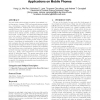4344 search results - page 18 / 869 » The resourcefulness of everyday design |
CE
2008
13 years 11 months ago
2008
E-Science has the potential to transform school science by enabling learners, teachers and research scientists to engage together in authentic scientific enquiry, collaboration an...
HRI
2010
ACM
14 years 6 months ago
2010
ACM
—Robots are poised to enter our everyday environments such as our homes and offices, contexts that present unique questions such as the style of the robot’s actions. Style-orie...
HICSS
2002
IEEE
14 years 4 months ago
2002
IEEE
As the proliferation of the Internet, especially World Wide Web, numerous information resources have been constructed. The characteristics of information resources on the Internet...
PUC
2007
13 years 10 months ago
2007
Many believe that ubiquitous computing will succeed when it has faded into the background of everyday life and work—that is, when it has become mundane. This paper examines the ...
MOBISYS
2009
ACM
14 years 11 months ago
2009
ACM
Top end mobile phones include a number of specialized (e.g., accelerometer, compass, GPS) and general purpose sensors (e.g., microphone, camera) that enable new people-centric sen...

